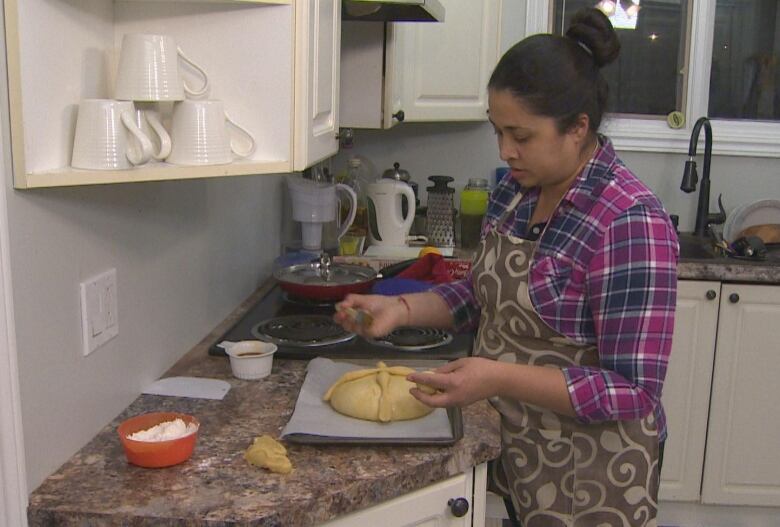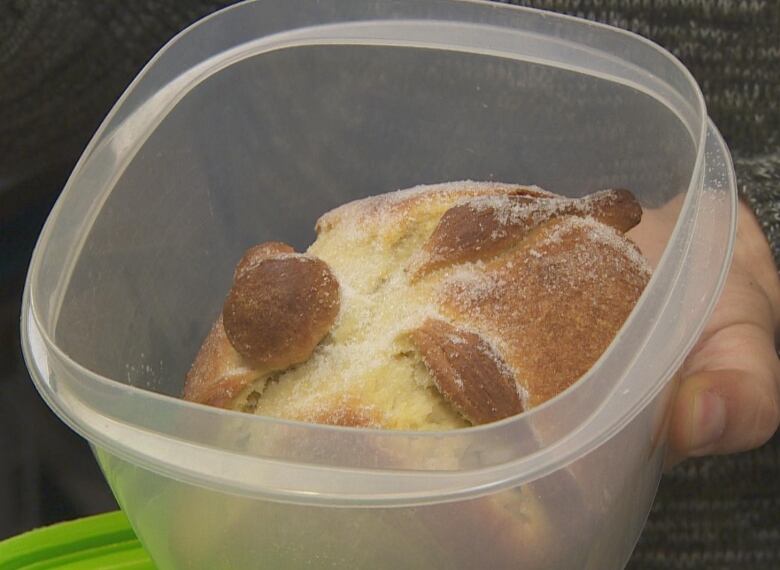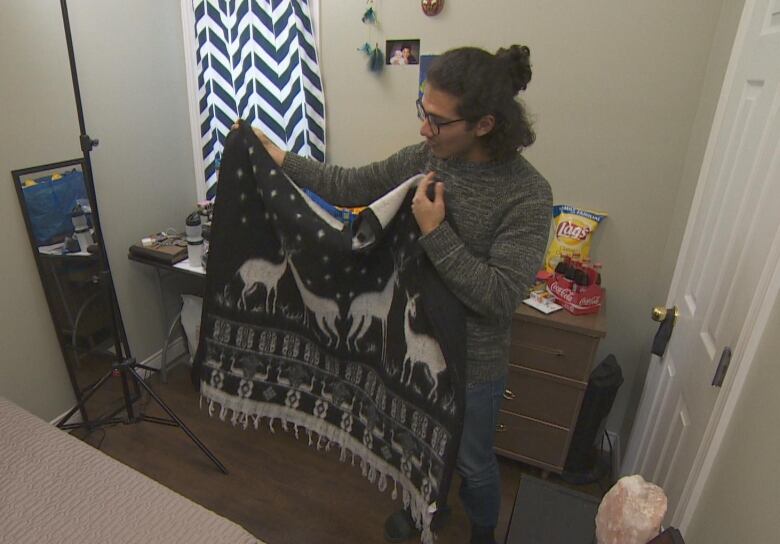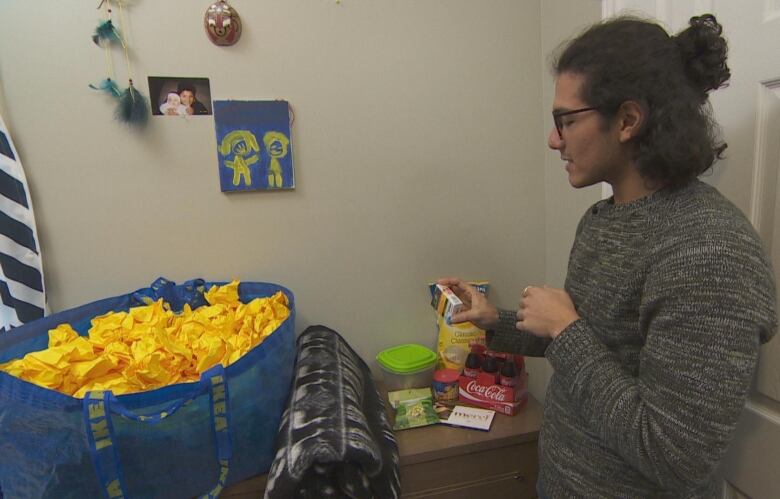Ponchos and petals: Meet the Mexicans bringing Da de Muertos to St. John's
This is like our Mexican version of Halloween

The imagery of the holiday Da de Muertoshas become more prevalent in Newfoundland and Labradorin recent years, thanks in part to movies like Coco and The Book of Life.
But there are a lot of things about the Mexicanholiday which translates to "Day of the Dead" in English that many Newfoundlanders and Labradorians still may not know.
For instance, a traditional Mexican bread called pan de muerto is often eaten during the festivities.
"In the altar, it symbolizes the product of the earth. But also it's like a gift from the hosts to the deceased family members that are joining the table," said Santiago Guzman, who isoriginally from Mexico City but now lives in St. John's.
Guzman and his partner are going to celebratethe holiday away from homefor the very first time on Friday. Da de Muertos is meant to honour the dead, and ithappens on Nov.1and 2.
There'san altar, candlesand food involved but the festivities arenot going to be a cakewalk there's a ton of preparation involved, including finding that bread.
Luckily, Guzman found a woman who was baking the dish, which is made weeks in advance, rightin St. John's.
"I was very lucky to get the pan de muerto, even. I had no idea that that was even possible," he said.
"It's delicious, it's just a vanilla bread coated with sugar. I would eat it every single day of October. This is my favourite bread."
That favourite food is just one of the many elements that make up Da de Muertos.
"This is like our Mexican version of Halloween," Guzman explained.
"What we do in Mexico, we celebrate our deceased family members. So we set up an altar for them to come and spend an evening with us. It's an opportunity we have to spend time with them once a year."
Cultural heritage, freshly baked
Melissa Gonzalezis the woman responsible for getting Guzman his pan de muerto.
She's also a Mexican living in St. John's although she's from Mazatlan, not Mexico City.
"This tradition is not as strong in my place, like in Mexico City," Gonzalez said. "But we are still making something. We are going to keep that tradition."

She's celebrating the holiday herself on Sunday.
"We will invite some friends, some Mexican and Latin friends," she said. "They will eat here, this bread. Usually you can eat this bread with hot chocolate."
That special bread has a few surprise ingredients that make it different from your average loaf. The flour is made with orange zest and brushed with orange tea. Some parts of the bun are hard and shaped like bones, too.
"It's because it's like a representation of the dead," Gonzalez said. "We try to make the shape of the bones in the bread, so it looks more like bread of the dead."
Bringing Mexican culture to St. John's
Traditionally, Guzman says that during Da de Muertos, Nov.1is reserved for honouring youth that have died, while Nov. 2is forolder relatives, though the celebrations are not always that way.

"What we usually do, from my experience, is doing everything on Nov.1," said Guzman.
When that day comes this year, it will be the very first time that Guzman has celebrated Da de Muertos in N.L. despite living here for four years.
When his grandfather died a few months ago and he was unable to fly home to be with his family, it made him consider things.
I say that I am an adopted Newfoundlander.- Santiago Guzman
"For me that was a reality check of family. And I was like, 'OK, I can't be there right now,'" Guzman said.
"Sothen for me, having this opportunity to celebrate both my culture and teach it to my partner and share a little bit of what we do I think it's just like a beautiful opportunity."
He says that he's excited to share this piece of his culture with St. John's.
"I say that I am an adopted Newfoundlander. This is, to me, is very important to be able to tell this particular story."
A poncho for the winter
Part of Da de Muertos involves placing your loved ones' belongings on the altar. Luckily, Guzman had his grandfather's poncho handy here in St. John's for the ceremony.
"My grandmother gave me this poncho that belonged to my grandfather," he said.
"She said, 'I am pretty sure that he would be happy that you have it, especially since you are going up north and it will be cold.'"

The poncho might not help him stay warm outside when January comes around, but it worked just fine for Da de Muertos.
Another element of the ceremony involves placing a trail of marigold petals between your doorstep and the altar. Guzman didn't have any marigold petals, so he used yellow paper instead.
Favourite foods ofdead family members arealso placed alongside their belongings.That food takes on a special role in the story of the holiday.
"There is this belief that our family members come, and actually eat the things that are left at the altar," he said.
"So when they eat, if I eat it the day after, it is assumed that the food will be tasteless because the spirits will be taking out the taste of the food."

Just as food plays a joyful role in many holidays around the world, the same in true forDa de Muertos where even if the holiday is about remembering loved ones who have been lost, the focus is on the happiness of the memories that remain.
"This is sort of our Thanksgiving moment. We try to have a little bit of a moment where we're setting up the altar perhaps we're cooking their favourite meal and we try to talk about our family members that have passed away," Guzman said.
"So that is a beautiful moment for us to remember them, with so much joy."
With files from Here & Now












_(720p).jpg)


 OFFICIAL HD MUSIC VIDEO.jpg)
.jpg)



























































































